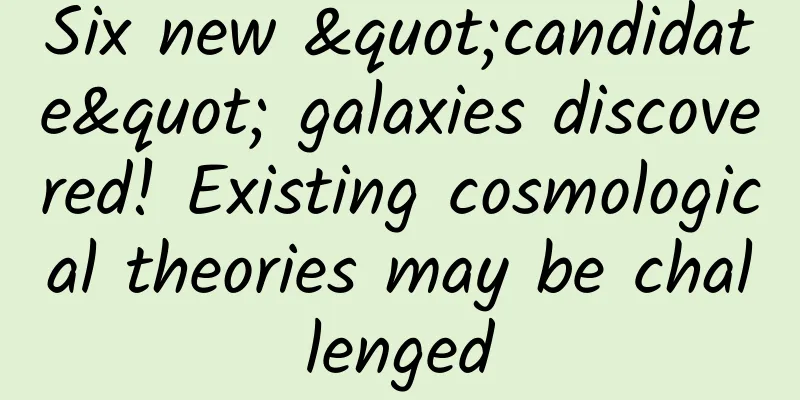Six new "candidate" galaxies discovered! Existing cosmological theories may be challenged

|
Xinhua News Agency, Beijing, February 23 (Xinhua) -- The James Webb Space Telescope discovered six "candidate" galaxies, according to a paper published in the well-known British academic journal Nature on February 22. They appeared shortly after the Big Bang and formed at a speed that is difficult to explain with existing astronomical theories. The researchers are now waiting to confirm the identities of these objects, believing that some of them are likely to be massive galaxies. Once confirmed, their existence will overturn the scientific community's understanding of the early universe, and some basic rules of cosmology may need to be revised. On July 11, 2022, the US government released the first full-color deep-space image of the universe taken by the James Webb Space Telescope, which was taken of the galaxy cluster "SMACS 0723". NASA said that this is the most distant and clearest infrared image of the universe to date. Xinhua News Agency "A baby less than 7 centimeters tall and weighing 70 kilograms" The observation data comes from the first data set released by the Webb telescope. When a dedicated team of researchers from Australia, the United States, Denmark and Spain analyzed the data, they found some "fuzzy spots" in an unnoticed area near the Big Dipper, which were abnormally bright and unusually red. In astronomy, red represents "older". As the universe continues to expand, ultraviolet and visible light emitted by early luminous objects move toward the red end of the spectrum, and eventually reach near-Earth space in the form of infrared light. This phenomenon is called "redshift". As the "successor" to the Hubble Space Telescope, the Webb telescope mainly observes in the infrared band, which helps scientists "see the origin of everything at a closer distance". In contrast, the Hubble telescope mainly observes in the visible and ultraviolet bands. After analysis, the researchers believe that the six red dots they found may be galaxies, which were formed about 500 million to 700 million years after the Big Bang, when the universe was about 3% of its current age. According to AFP, two of the galaxies appeared in images taken by the Hubble Telescope, but were so blurry that they were not noticed at the time. This is an image of the universe taken by the James Webb Space Telescope and released by NASA on July 12, 2022. Xinhua News Agency Based on the data, the researchers calculated that the total mass of stars in these "candidate" galaxies is equivalent to 10 billion to 100 billion suns. One of the galaxies seems to be as massive as the Milky Way, but its density is 30 times that of the Milky Way, and it looks fundamentally different from the galaxies in the current universe. Reuters quoted Ivo Rabe, an astrophysicist at Swinburne University of Technology in Australia and the first author of the paper, as saying: "If the Milky Way is a normal-sized adult, 1.75 meters tall and weighing 70 kilograms, then these galaxies are like one-year-old babies, weighing about the same (as adults) and less than 7 centimeters tall. The early universe was full of weirdness." According to the researchers, these celestial bodies were formed in the early universe. According to existing astronomical theories, "only some tiny, young 'infant' galaxies could exist at that time." It was unexpected that galaxies as mature as the Milky Way existed so early. It should be noted that it took more than 13 billion years for the Milky Way to reach its current size. In addition, the masses of these "candidate" galaxies are much larger than those inferred by the standard model of cosmology, with a difference of up to 100 times. If the stars inside them are added together, "it will exceed the total mass of matter in the universe at that time." This is an image of the universe taken by the James Webb Space Telescope and released by NASA on July 12, 2022. Xinhua News Agency This contradicts current cosmological models Rabe said that for young galaxies to "grow" to the size of the Milky Way within 700 million years, their growth rate must be about 20 times that of the Milky Way. The existence of such massive galaxies so soon after the Big Bang contradicts the current cosmological model, which represents the best scientific understanding of how the universe works. One possible explanation for this contradiction is that there are other ways in which galaxies are formed that are currently unknown to humans. "It seems that there is a channel that is a fast lane, and the fast lane creates monsters." According to the current mainstream cosmological theory, the universe originated from a big bang 13.8 billion years ago. From 380,000 to about 150 million years after the big bang, it experienced a "dark age" without any luminous celestial bodies. At the end of the "dark age", the large-scale structure of the universe appeared under the gravitational force of dark matter, and the first generation of stars and galaxies were born. Dark matter is a type of invisible matter that may exist in theory. Scientists have discovered many phenomena in astronomical observations that appear to violate Newton's law of universal gravitation, but they can be well explained under the assumption that dark matter exists. According to scientists' calculations, ordinary matter accounts for about 15% of the total mass of matter in the universe, and the remaining 85% is dark matter. This is an image of the universe taken by the James Webb Space Telescope and released by NASA on July 12, 2022. Xinhua News Agency Emma Chapman, an astrophysicist at the University of Nottingham in the UK, told the Guardian that if such a huge galaxy could be formed shortly after the Big Bang, it means that "the dark ages may not be so dark, and perhaps a large number of stars were formed in the universe much earlier than we thought." According to the website of the British quarterly Science Letter, Emma Curtis-Lake, an astronomer at the University of Hertfordshire, gave another explanation: some of the newly discovered galaxies have supermassive black holes at their cores, and what looks like starlight may be the light emitted by the gas and dust swallowed by the black hole. The Webb telescope previously photographed an active supermassive "candidate" black hole, and analysis showed that it was formed earlier than the above-mentioned "candidate" galaxy. However, scientists are still unable to explain why supermassive black holes were formed so quickly after the Big Bang. Curtis-Lake said that in order to confirm the "identity" of newly discovered celestial bodies, astronomers need to further confirm their distance, mass, spectral information, etc. Rabe said that the Webb telescope has taken spectra of some galaxies, "If we are lucky, we will know more in a year." (Wang Xinfang) |
<<: How to take the high-speed rail? How to see a doctor? A practical guide for beginners →
>>: World Hate Cilantro Day丨Does cilantro smell good or bad to you?
Recommend
12.12 is coming, please check out the wedding photography industry’s advertising secrets!
Following the popularity of 11.11, the 12.12 prom...
How to promote products overseas on TikTok?
In the past few years, the advertising market see...
Kuaishou e-commerce traffic growth plan
In the first part, we will experience and analyze...
University of Mainz, Germany: Study finds link between soil pollution and heart disease
Pesticides and heavy metals in soil may have adve...
What kind of mobile phones do the bosses prefer? Apple or Huawei? None of them
Which company has the best-selling mobile phone i...
Why do some advertisements make you want to move after watching them?
Have you seen ads like this: " U2 resin lens...
JAC Motors: Structural adjustment has yielded initial results, with new energy vehicles performing well
With the transformation of my country's econo...
The latest update on VAT refund policy in 2022: Which companies can apply? These 4 conditions need to be met!
During the 2022 Two Sessions, Premier Li Keqiang ...
Xiaomi, on the eve of a breakout or on the brink of falling?
"Good student" Xiaomi handed in a finan...
Lichuan SEO Training: Why do search engine marketing? Which is the largest search engine?
Many people use search engines when they surf the...
Increase conversion rate by 50% in 4 steps, revealing the underlying logic of traffic acquisition!
When it comes to customer acquisition, there are ...
Why does Apple Maps suck?
At the WWDC 2014 conference, Apple brought iOS 8, ...
What are the daily work contents of SEO and what are the tasks of SEO?
Before I knew it, I have been working in SEO for ...
Behind Google's "100 million times faster": How is quantum computing achieved?
Recently, Google launched the D-Wave quantum compu...
How to achieve 100,000 downloads in 2 months with zero budget for APP operation and promotion?
For promoters, the most difficult time is the fir...









